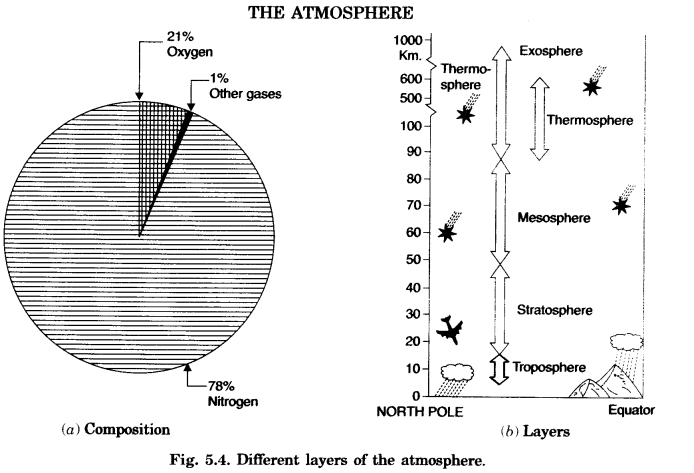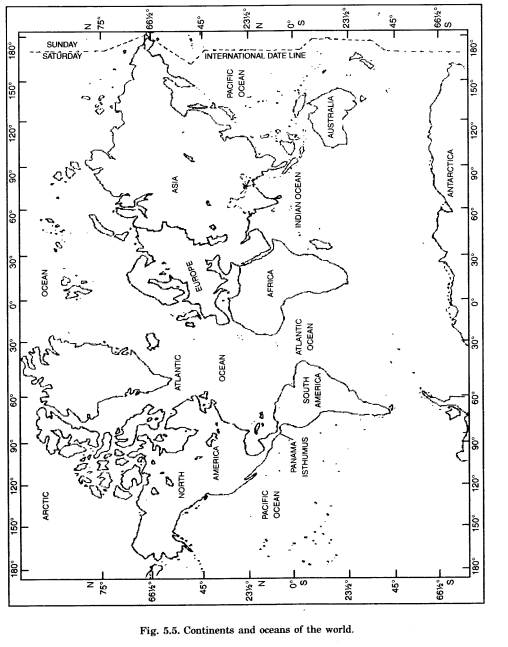Major Domains of the Earth Class 6 Extra Questions Social Science Geography Chapter 5
NCERT Extra Questions for Class 6 Social Science Geography Chapter 5 Major Domains of the Earth
Major Domains of the Earth Class 6 Extra Questions Very Short Answer Type
- Waves
- Tides and
- Currents
Major Domains of the Earth Class 6 Extra Questions Short Answer Type
- The earth is the only planet of the Solar System which has life.
- It is the home of mankind.
- The life sustaining elements are land, water and air that are present on the earth.
Lithosphere: The solid portion of the earth is Lithosphere. In Greek Litho means stone or rock. It means the sphere made of rocks is termed as Lithosphere.
Atmosphere: The gaseous envelope surrounding the earth is Atmosphere. In Greek ‘atmo’ means air. The sphere made of air is atmosphere.
Hydrosphere: The area containing water is called Hydrosphere. Word, Hydrosphere has been derived from the Greek word ‘Hydro’ which means water. Hydrosphere contains water in all its forms.
Biosphere has been derived from the Greek word ‘Bio’. It includes all parts of earth where all types of organisms live. It is the narrow zone of contact of land, water and air where all forms of life are found.
All the four realms are not separate entities, they are considerably intermingled.
- The earth is surrounded by an envelope of air.
- It is called atmosphere.
- This thin blanket of air is an integral and the most important aspect of the planet. It is very important to us as it enables us to breathe and protects us from the harmful effects of the sun’s rays.
- Atmosphere is composed mainly of nitrogen and oxygen.
- They both make up about 99% of clean, dry air (Nitrogen 78%; Oxygen 21%)
- Other gases like Carbon-dioxide; argon and others comprise 1% by volume.
- Oxygen is the breath of life while nitrogen helps in the growth of living organisms.
- Carbon-dioxide is present in the air in minute amount but is very important.
- It absorbs heat radiated by the earth and keeps the surface of the earth warm.
- It is the highest at sea level.
- It decreases rapidly with increase in height.
- Climbers experience problems in breathing due to decrease in density.
- Temperature also decreases with increase in height.
- The atmosphere exerts pressure on the earth due to weight in the air. Thus air pressure is the weight of the air.
- Pressure varies from place to place.
- The difference in air pressure makes the air move.
- Moving air is known as wind. It means wind is formed due to the difference in air pressure.
- The biosphere is the narrow zone of contact between the land, water and air, comprising all forms of life.Features:
- There are several species of organism in the biosphere.
- They vary in size from microbes and bacteria to huge mammals.
- All the living organisms including human are linked to each other and to the biosphere for survival.
- Soil erosion is increased.
- Loose soil are deposited in river beds. Level of river beds rises and during excessive rains they are not capable of keeping the whole of water under control. Hence floods are caused.
- Felling of trees also reduces the quantity of oxygen we get from them. Hence new problems grow up.
- Increase in industries has led to increase in pollution.
- Carbon-dioxide is an important constituent of air.
- But increase in amount of CO2 due to human activities has led to increase in global temperatures. This is termed as global warming.
- It comprises (of) the rocks of earth’s crust.
- It also has shallow layers of soil that contain nutrient elements which are necessary for all types of organisms.
Major Domains of the Earth Class 6 Extra Questions Long Answer Type

- The atmosphere extends upto a height of about 1,600 kilometres.
- The atmosphere is divided into five layers based on composition, temperature and other properties.
- They are in ascending order from the earth’s surface:
- Troposphere
- Stratosphere
- Mesosphere
- Thermosphere, and
- Exosphere
- The ozone layer crucial to life on the earth is located in the stratosphere.
- The organisms found in the biosphere are broadly divided into plant kingdom and animal kingdom.
- The four realms of the earth interact with one another and affect one another in some way or the other.
The growth of human population is a major cause of change in the biosphere. The growing population requires space for living. This leads to increase of silt in rivers that results ultimately into floods.
- Floods provide new soil or alluvial (sand and earth).
- But simultaneously floods destroy human habitation and cause complete disruption in smooth living of people.
- The two main divisions of the earth’s surface are:
- The large landmasses are known as the continents.
- The ocean basins, contain large water bodies.
- Continents and Oceans differ from each other in their relative levels.
- All the Oceans of the world are connected with one another.
- Level of seawater remains the same everywhere. It is called sea level. The continents have an average depth of 3800 metres in Oceans.
- The highest point on Continents is 8848 metres in the form of Mount Everest in Nepal while the deepest depth is 11022 metres in the form of Mariana Deep (Mariana Trench) in the Pacific Ocean.
1. Asia
- Asia is the largest continent.
- It covers about 1/3 of the total land area of the earth.
- Asia lies in the eastern hemisphere.Alt is separated from Europe by Ural mountain on the west’
- The combined landmass of Asia and Europe is called Eurasia.
2. Europe
- Europe is the second smallest continent.
- Water bodies bound it on three sides.
- The Atlantic Ocean lies on the western side, the Arctic Ocean on the Northern side and the Mediterranean sea on the southern side.
3. Africa
- Africa is the second largest continent after Asia. Equator runs almost through the middle of this continent.
- The wider part of Africa lies in the Northern hemisphere.
- It is the only continent which both the Tropic of Cancer and the Tropic of Capricorn pass through.
- The continent is bounded on all sides by oceans and seas.
- The largest hot desert of the world, the Sahara desert is situated in Africa.
- The world’s longest river, Nile, flows through Africa.
4. North America
- North America is the third largest continent of the world.
- It is linked with South America by the Panama Isthmus.
- It lies completely in the Northern and Western Hemisphere.
- Three oceans surround it. They are the Pacific Ocean in the West, The Atlantic Ocean in the East and the Arctic Ocean in the North.
5. South America
- South America lies mostly in the Southern Hemisphere.
- It is bounded by the Pacific Ocean in the west, by Atlantic Ocean in the East and by Antarctic Ocean in the South.
- The world’s longest mountain range, the Andes runs through its full length.
- World’s largest river, Amazon flows through this continent.
6. Australia
- Australia is the smallest continent of the world.
- It lies entirely in the Southern hemisphere.
- It is surrounded on all sides by oceans and seas so it is called an island continent.
7. Antarctica
- Antarctica is completely in the Southern Hemisphere.
- It is a continent larger than Europe and Australia put together.
- The South Pole lies almost at the centre of this continent. Hence the continent is permanently covered with thick ice’sheets.
- It has no permanent human settlements.

- Numerous countries have set up their research stations op. this continent, India has set up Maitri, Dakshin Gangotri as its research centres here.
- The earth is called the blue planet because 71% of the earth is covered with water and 29% with land.
- Hydrosphere consists of water in all its forms in the oceans, lakes, ponds, rivers, streams, ice caps and ice sheets. On the surface as surface water and below the surface of the earth, in the form of under-ground water.
- Water is also present in the atmosphere in the form of water vapour.
- In other words running water in rivers and oceans, in lakes, glaciers, underground water and the water vapour in the atmosphere all make the hydrosphere.
- The oceans form the major part of the hydrosphere.
- They are all connected with one another.
- It is spread on 33.3% area of the earth.
- Mariana Trench, the deepest part of the earth lies under the Pacific Ocean.
- The Pacific Ocean is circular in shape.
- It is bounded by Asia and Australia on one side and North and South Americas on the other.
The Atlantic Ocean is the second largest ocean of the world.
- It is ‘S’ shaped.
- It is flanked by the North and the South America on the Western side and Europe and Africa on the eastern side.
- Its coastline is highly indented. This irregular and indented coastline facilitates development of natural harbours.
- The Atlantic ocean is the busiest ocean from the point of view of commerce.
The Indian Ocean is the only ocean which has been named after India.
- The shape of this ocean is almost triangular.
- In the North, it is bounded by Asia, by Africa in the west and by Australia in the east. Indian Peninsula divides it into two parts.
- The Arabian Sea and the Bay of Bengal.
The Arctic Ocean is located within the Arctic circle and surrounds the North Pole.
- It is actually a northward extension of Atlantic Ocean.
- A narrow water body named the Berring Strait connects it with Pacific Ocean.
- It is bounded by the northern coasts of North America and Eurasia in the north.
Major Domains of the Earth Class 6 Extra Questions Multiple Choice Questions
Choose the correct answer:










